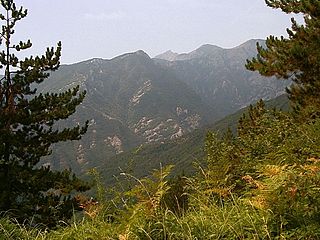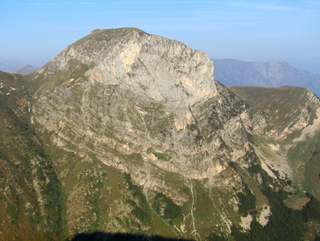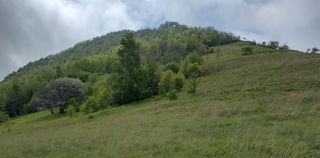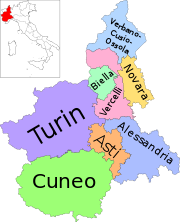
The Ligurian Alps are a mountain range in northwestern Italy. A small part is located in France. They form the south-western extremity of the Alps, separated from the Apennines by the Colle di Cadibona. The Col de Tende and the Vermenagna valley separate them from the Maritime Alps. They form the border between Piedmont in the north and Liguria in the south.

Monte Settepani is 1,386 metres high mountain in Liguria, northern Italy, part of the Ligurian Prealps.

Colle San Bernardo (957 m) is a mountain pass in the Province of Cuneo (Italy).

Monte Monega is a 1,882-metre (6,175 ft) mountain of the Ligurian Alps, in Italy.

Carmo di Brocchi is a 1,610-metre (5,282 ft) mountain of the Ligurian Alps, in Italy.

Monte Spinarda is a 1,357-metre (4,452 ft) mountain of the Ligurian Prealps in Italy.

The Cime de Mussun (French) or Cima Missun (Italian) is a mountain of the Ligurian Alps.

The Bric Costa Rossa is a mountain of the Ligurian Alps located in Piedmont.

The Cima della Fascia is a mountain of the Ligurian Alps located in Piedmont.

The Monte Mongioie is a mountain of the Ligurian Alps located in Piedmont.

The Monte Antoroto is a mountain of the Ligurian Alps located in Piedmont.

The Cima delle Saline is a mountain of the Ligurian Alps located in Piedmont.

The Punta Mirauda is a mountain of the Ligurian Alps located in Piedmont.

Monte Cianea is a 1,226-metre (4,022 ft) mountain of the Ligurian Prealps, in Italy.

The Cima Cars is a mountain of the Ligurian Alps located in Piedmont.

Monte Peso Grande o Castell'Ermo (1.092 m) is a mountain of the Ligurian Prealps, the eastern section of the Ligurian Alps.

The Monte Camulera is a mountain of the Ligurian Prealps, the eastern section of the Ligurian Alps.

The Monte Alpe is a mountain of the Ligurian Prealps, the eastern section of the Ligurian Alps.
The Ligurian Prealps are a mountain range in northwestern Italy. They belong to the Ligurian Alps and are located between the regions of Piemonte and Liguria. Their highest summit is the monte Armetta, at an elevation of 1,739 metres (5,705 ft).

Monte Pietraborga is a mountain in the Cottian Alps, Metropolitan City of Turin in Piedmont, north-western Italy. It is located between the comuni of Trana and Sangano.



























